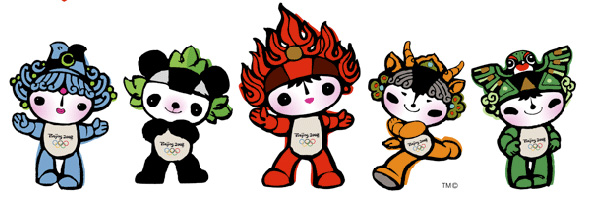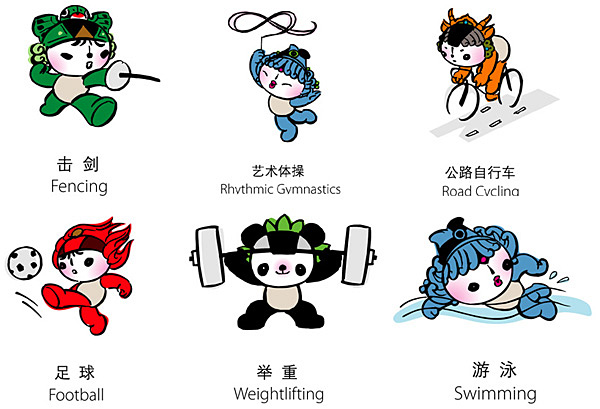Olympia-Maskottchen Peking 2008 vorgestellt
Das bunte Quintett heißt »Die Freundlichen Fünf« und
wird die Olympischen Spiele 2008 in Peking als Maskottchen begleiten. 1000 Tage
vor der Eröffnungsfeier wurden sie jetzt im Rahmen eines Festaktes
vorgestellt. Anzahl und Farben der sympathischen Truppe sind den olympischen
Ringen entnommen, ihr Charakter basiert auf traditionelle chinesische
Tiersymbole. Die Veranstalter werden die Comic-Wesen auch für die
Sportarten-Piktogramme einsetzen.
Weiterlesen ...

© Beijing Organizing Committee for the Games of the XXIX Olympiad
Weiterlesen ...

© Beijing Organizing Committee for the Games of the XXIX Olympiad
Der Auftrag der »Freundlichen Fünf«: Die Botschaft der
Freundschaft und des Friedens von China aus in alle Welt zu tragen. Das Quintett
repräsentiert vier symbolbeladene chinesische Tiere – Fisch, Panda,
tibetanische Antilope und die Schwalbe – sowie das olympische Feuer.
Natürlich hat jede Figur ihren eigenen Namen: Beibei, Jingjing, Huanhuan,
Yingying und Nini; aneinander gereiht ergeben diese den Satz »Bei Jing
Huan Ying Ni« was nichts anderes bedeutet als »Willkommen in
Peking«.
Übrigens wurden die Moskottchen aus 662 Design-Einreichungen ausgewählt, von denen 614 (93 %) aus China, 11 aus Hong Kong, Macao und Taiwan und nur 37 aus dem Rest der Welt kamen. Das erste Maskottchen bei Olympischen Spielen war der Dackel Waldi 1972 in München.

Die Maskottchen der Olympischen Spiele 2008: Beibei (Fisch), Jingjing (Panda), Huanhuan (Flamme), Yingying (Antilope) und Nini (Schwalbe)
© Beijing Organizing Committee for the Games of the XXIX Olympiad
Das Nationale Olympische Komitee von China liefert auf der Maskottchen-Seite jede Menge Informationen zur Bedeutung der einzelnen Figuren:
Beibei (Fisch)
»In China’s traditional culture and art, the fish and water designs are symbols of prosperity and harvest. And so Beibei carries the blessing of prosperity. A fish is also a symbol of surplus in Chinese culture, another measure of a good year and a good life. The ornamental lines of the water-wave designs are taken from well-known Chinese paintings of the past. Among the Five Friendlies, Beibei is known to be gentle and pure. Strong in water sports, she reflects the blue Olympic ring.«
Jingjing (Panda)
»Jingjing makes children smile – and that’s why he brings the blessing of happiness wherever he goes. You can see his joy in the charming naivety of his dancing pose and the lovely wave of his black and white fur. As a national treasure and a protected species, pandas are adored by people everywhere. The lotus designs in Jingjing's headdress symbolize the lush forest and the harmonious relationship between man and nature. Jingjing is charmingly naïve and optimistic. He is an athlete noted for strength who represents the black Olympic ring.«
Huanhuan (Flamme)
»In the intimate circle of Friendlies, Huanhuan is the big brother. He is a child of fire, symbolizing the Olympic Flame and the passion of sport. Huanhuan stands in the center of Friendlies as the core embodiment of the Olympic spirit. And while he inspires all with the passion to run faster, jump higher and be stronger, he is also open and inviting. Huanhuan is outgoing and enthusiastic. He excels at all the ball games and represents the red Olympic ring.«
Yingying (Antilope)
»Like all antelopes, Yingying is fast and agile and can swiftly cover great stretches of land as he races across the earth. A symbol of the vastness of China's landscape, the antelope carries the blessing of health, the strength of body that comes from harmony with nature. The selection of the Tibetan Antelope reflects Beijing commitment to a Green Olympics. Strong in track and field events, Yingying is a quick-witted and agile boy who represents the yellow Olympic ring.«
Nini (Schwalbe)
»Nini’s figure is drawn from this grand tradition of flying designs. Her golden wings symbolize the infinite sky and spread good-luck as a blessing wherever she flies. Swallow is also pronounced ›yan‹ in Chinese, and Yanjing is what Beijing was called as an ancient capital city. Among the Friendlies, Nini is as innocent and joyful as a swallow. She is strong in gymnastics and represents the green Olympic ring.«
Der offiziellen Internetseite für die Olympischen Spiele 2008 ist zu entnehmen, dass die Maskottchen auch auf den Piktogrammen für die einzelnen Sportarten zum Einsatz kommen. Das lässt nicht unbedingt auf bunte und freundliche Spiele schließen, aber auf eine solche Kommunikation. Muss man die Piktogramme von Otl Aicher für die Olympischen Spiele in München neu bewerten?

Die munteren Maskottchen werden 2008 auch die Sportarten symbolisieren
© Beijing Organizing Committee for the Games of the XXIX Olympiad
Wir erinnern uns (oder auch nicht) an die Olympia-Maskottchen der vergangenen 33 Jahre:

Übrigens wurden die Moskottchen aus 662 Design-Einreichungen ausgewählt, von denen 614 (93 %) aus China, 11 aus Hong Kong, Macao und Taiwan und nur 37 aus dem Rest der Welt kamen. Das erste Maskottchen bei Olympischen Spielen war der Dackel Waldi 1972 in München.

Die Maskottchen der Olympischen Spiele 2008: Beibei (Fisch), Jingjing (Panda), Huanhuan (Flamme), Yingying (Antilope) und Nini (Schwalbe)
© Beijing Organizing Committee for the Games of the XXIX Olympiad
Das Nationale Olympische Komitee von China liefert auf der Maskottchen-Seite jede Menge Informationen zur Bedeutung der einzelnen Figuren:
Beibei (Fisch)
»In China’s traditional culture and art, the fish and water designs are symbols of prosperity and harvest. And so Beibei carries the blessing of prosperity. A fish is also a symbol of surplus in Chinese culture, another measure of a good year and a good life. The ornamental lines of the water-wave designs are taken from well-known Chinese paintings of the past. Among the Five Friendlies, Beibei is known to be gentle and pure. Strong in water sports, she reflects the blue Olympic ring.«
Jingjing (Panda)
»Jingjing makes children smile – and that’s why he brings the blessing of happiness wherever he goes. You can see his joy in the charming naivety of his dancing pose and the lovely wave of his black and white fur. As a national treasure and a protected species, pandas are adored by people everywhere. The lotus designs in Jingjing's headdress symbolize the lush forest and the harmonious relationship between man and nature. Jingjing is charmingly naïve and optimistic. He is an athlete noted for strength who represents the black Olympic ring.«
Huanhuan (Flamme)
»In the intimate circle of Friendlies, Huanhuan is the big brother. He is a child of fire, symbolizing the Olympic Flame and the passion of sport. Huanhuan stands in the center of Friendlies as the core embodiment of the Olympic spirit. And while he inspires all with the passion to run faster, jump higher and be stronger, he is also open and inviting. Huanhuan is outgoing and enthusiastic. He excels at all the ball games and represents the red Olympic ring.«
Yingying (Antilope)
»Like all antelopes, Yingying is fast and agile and can swiftly cover great stretches of land as he races across the earth. A symbol of the vastness of China's landscape, the antelope carries the blessing of health, the strength of body that comes from harmony with nature. The selection of the Tibetan Antelope reflects Beijing commitment to a Green Olympics. Strong in track and field events, Yingying is a quick-witted and agile boy who represents the yellow Olympic ring.«
Nini (Schwalbe)
»Nini’s figure is drawn from this grand tradition of flying designs. Her golden wings symbolize the infinite sky and spread good-luck as a blessing wherever she flies. Swallow is also pronounced ›yan‹ in Chinese, and Yanjing is what Beijing was called as an ancient capital city. Among the Friendlies, Nini is as innocent and joyful as a swallow. She is strong in gymnastics and represents the green Olympic ring.«
Der offiziellen Internetseite für die Olympischen Spiele 2008 ist zu entnehmen, dass die Maskottchen auch auf den Piktogrammen für die einzelnen Sportarten zum Einsatz kommen. Das lässt nicht unbedingt auf bunte und freundliche Spiele schließen, aber auf eine solche Kommunikation. Muss man die Piktogramme von Otl Aicher für die Olympischen Spiele in München neu bewerten?

Die munteren Maskottchen werden 2008 auch die Sportarten symbolisieren
© Beijing Organizing Committee for the Games of the XXIX Olympiad
Wir erinnern uns (oder auch nicht) an die Olympia-Maskottchen der vergangenen 33 Jahre:
Herausgegeben: So - November 13, 2005 at 03:36 nachm. |
Quick Links
Suche
Fontblog Bildmemo
Kalender
| So | Mo | Di | Mi | Do | Fr | Sa |
Archiv
Rubriken
Statistik
Total entries in this blog:
Total entries in this category:
Published On: Aug 01, 2007 02:43 nachm.
Total entries in this category:
Published On: Aug 01, 2007 02:43 nachm.








